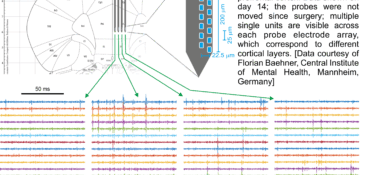Our silicon neural probes are minimally-invasive with exceptional signal-to-noise performance and minimal photoelectric artefact sensitivity, making them optimal for combined electrophysiology and optogenetics.
Exceptional signal-to-noise and chronic single unit stability over time
In the brain, device-size really matters. We use advanced approaches to create a range of high-channel count silicon neural probes with minimally-invasive dimensions and coupled with our very low electrode impedance (typically ~50 kOhm) our silicon neural probe microelectrodes allow you to record large yields of single units over extended time-periods in freely-behaving animals!
![]() No other microelectrodes, probes or whatever (!) can yet match this degree of in vivo performance with repeat-ability and reliability. We can’t promise this will always work in every animal but our silicon neural probe microelectrode technology gives you the best shot at achieving the elusive goal of recording the same neurons for extended periods of time.
No other microelectrodes, probes or whatever (!) can yet match this degree of in vivo performance with repeat-ability and reliability. We can’t promise this will always work in every animal but our silicon neural probe microelectrode technology gives you the best shot at achieving the elusive goal of recording the same neurons for extended periods of time.
In combination with our ultra-small chronic nano-Drives and our miniature digital headstages, you can create small-footprint, low-profile and compact implants that facilitate natural behavior and enable a scalable approach to multi-target network analyses with combined electrophysiology and optogenetics. Check out our surgery protocol to see how you can deploy our tool-sets to your best advantage.








